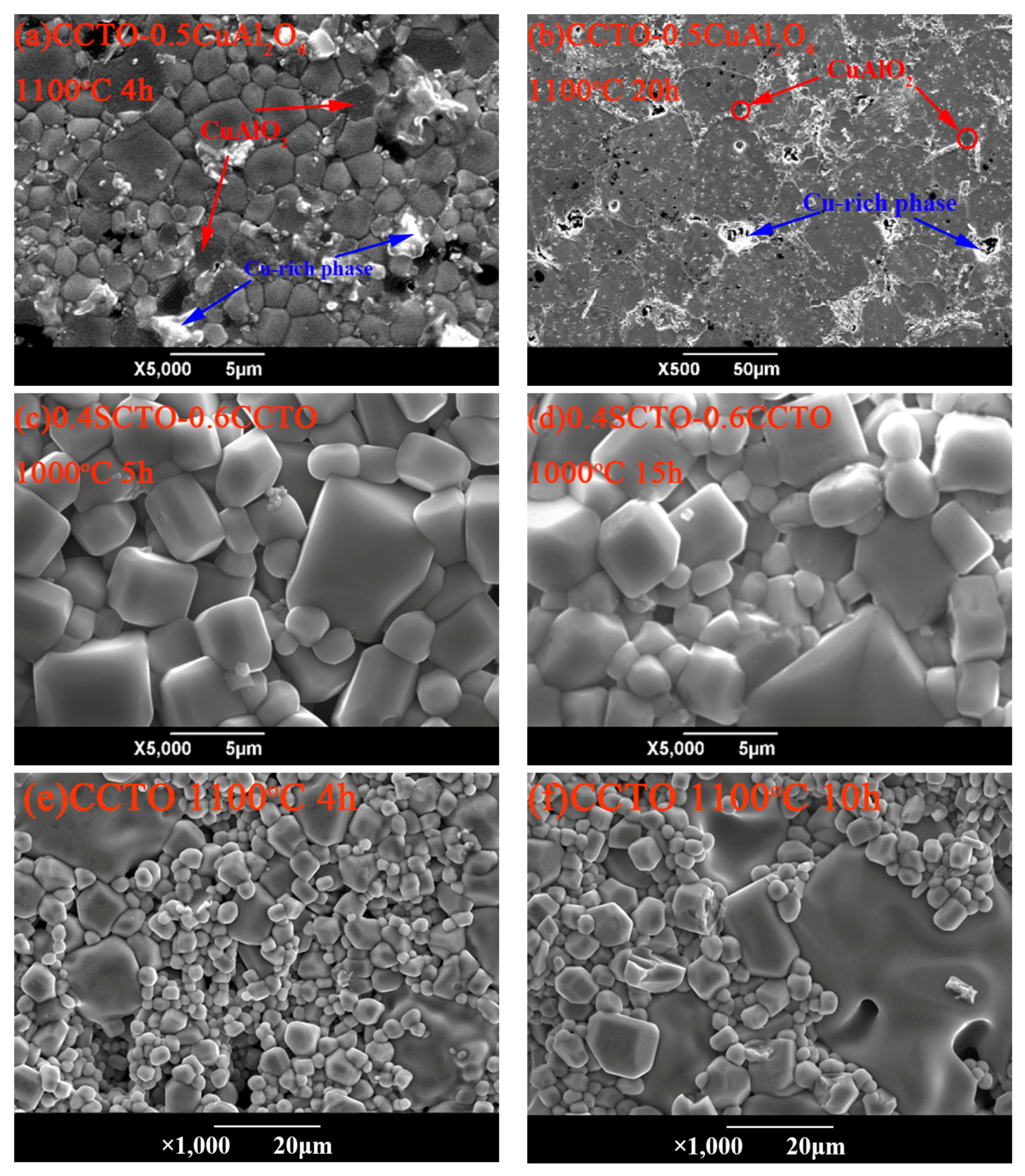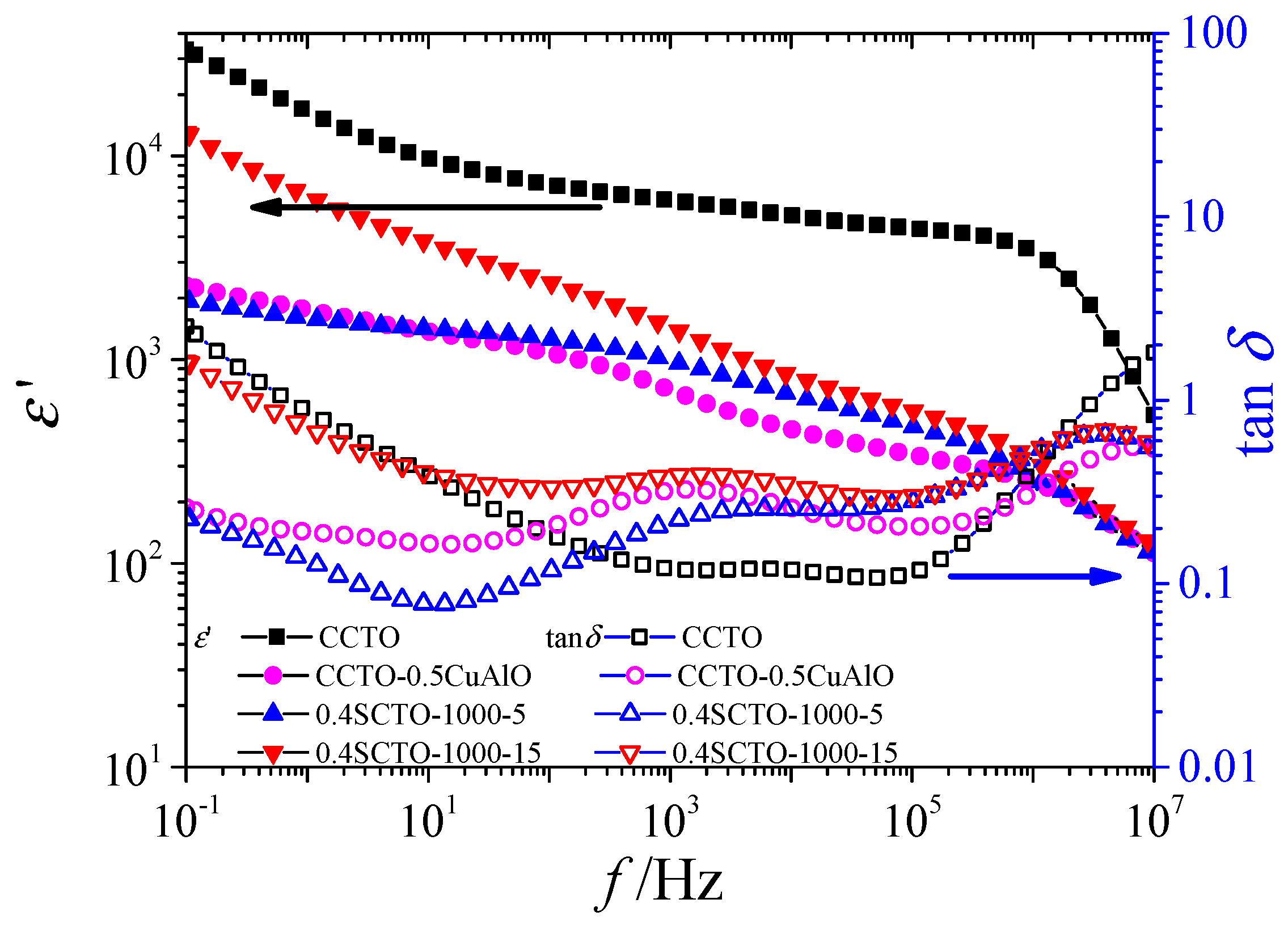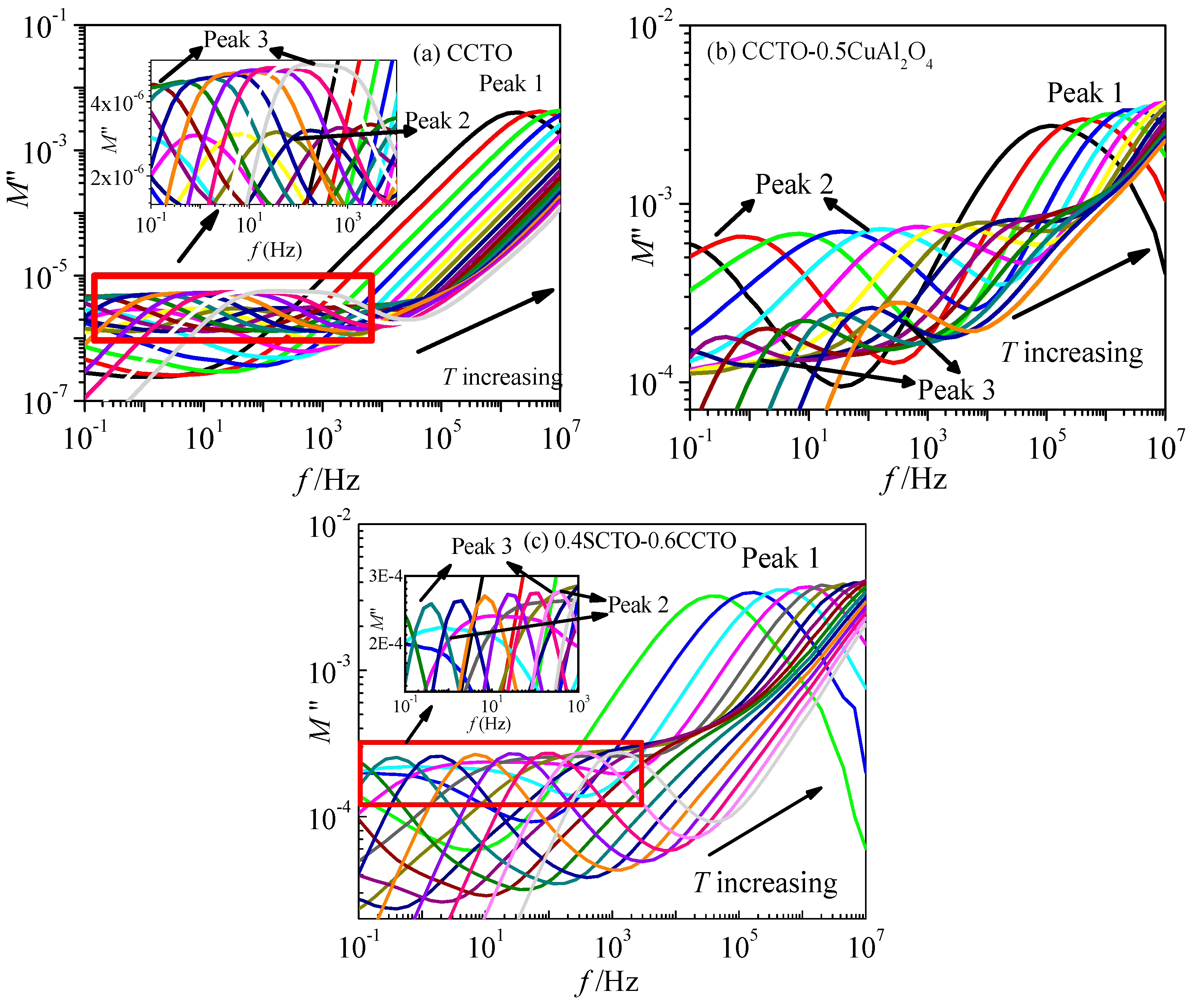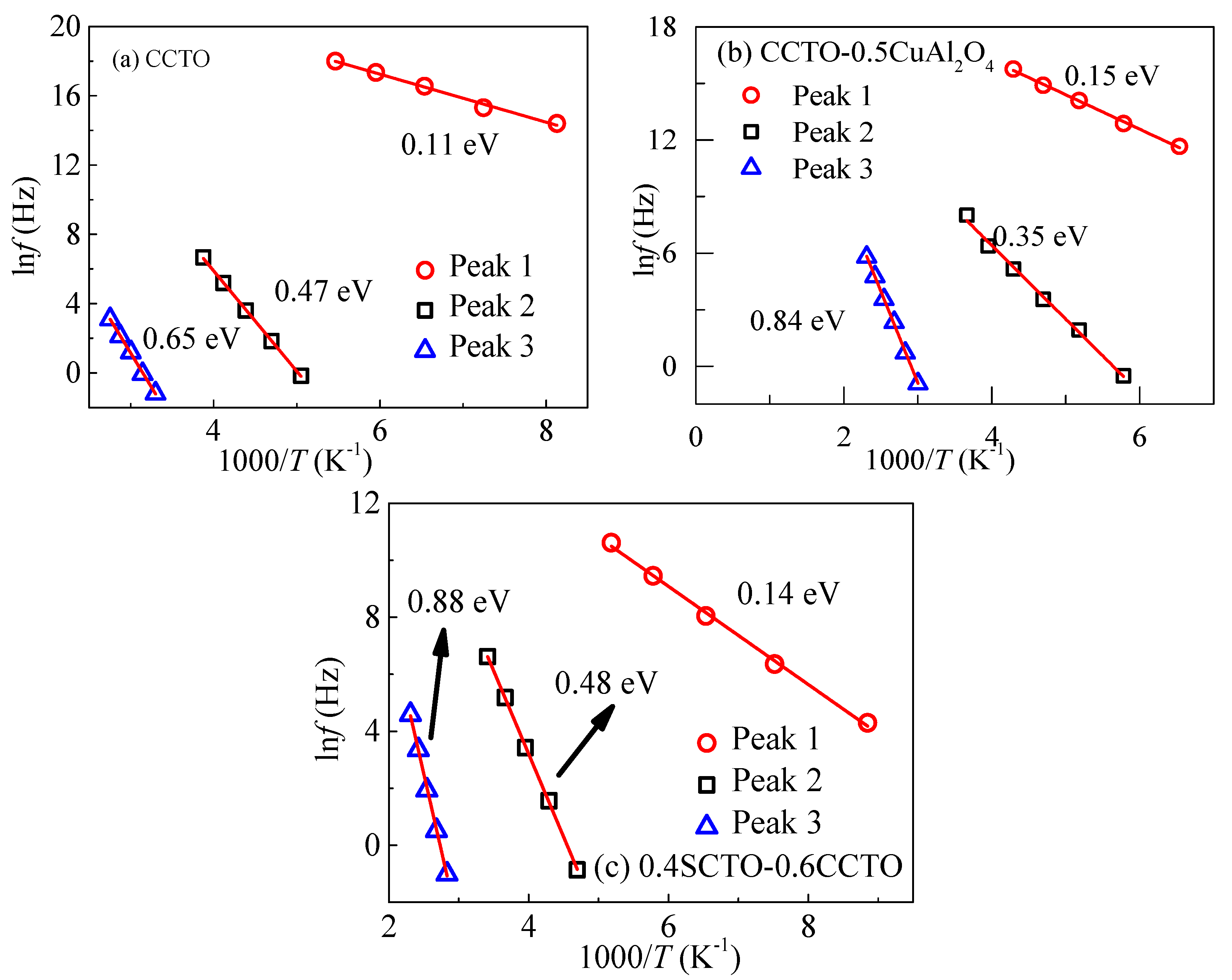1. Introduction
CaCu
3Ti
4O
12 (CCTO) ceramics has been extensively studied due to its colossal dielectric constant (CDC) up to 10
5, which is frequency independent in 10
2–10
6 Hz and exhibits excellent temperature stability over 100–600 K [
1]. In addition to CDC, non-ohmic characteristic has also been found in CCTO ceramics [
2], which is promising in applications of energy storage capacitors and over-voltage protection devices. Both the CDC property and non-ohmic characteristics are associated with defect-related double Schottky barrier between the semiconducting grains and insulating grain boundaries [
3,
4,
5]. The Schottky barrier blocks charge transport at grain boundaries, resulting in high nonlinear coefficient [
2] and active dipole movement for CDC property in an internal barrier layer capacitor (IBLC) model [
6].
It has been accepted that electrical property of CCTO ceramics is sensitive to the preparing method and the material composition [
7,
8]. Particularly, changes in the compositions to fabricate CCTO-based composite ceramics can notably affect the grain boundary structure and thus the dielectric performance [
9,
10]. In situ synthesis is an effective way to introduce homogeneous distribution of secondary phase. The phase equilibrium relations in the Cu
2O/CuO/Al
2O
3 [
11] system showed that, above 900 °C, the spinel phase of CuAl
2O
4 can be easily synthesized. Since the sintering temperature of CCTO ceramics is generally higher than 1000 °C, it can be expected that the spinel phase of CuAl
2O
4, which is unlike the perovskite-like phase in previously reported literature, can be easily synthesized in situ via the addition of Al
2O
3. The spinel phase is generally of high resistance, and the consumption of Cu-rich liquid phase by CuAl
2O
4 can help to control the grain growth. Meanwhile, composite ceramics with CCTO and other materials are also studied to improve the non-ohmic properties. A composite system of CCTO/CaTiO
3 (CCTO/CTO) has been reported by Kobayashi and Terasaki to have achieved a greatly reduced tan
δ as well as an enhanced nonlinear coefficient and a breakdown electric field [
10,
12]. CCTO/Y
2/3Cu
3Ti
4O
12 composite ceramics have been developed as increased nonlinear coefficients with low dielectric loss, obtained [
13] in our previous work.
In most research, the majority of breakdown fields for CCTO ceramics are less than 2 kV·cm
−1 [
14,
15]. According to the formula of stored energy
U = (
ε′
Eb2)/2, breakdown fields strongly affect the maximum stored energy. In our previous work, the breakdown voltage of CCTO could be enhanced to 13 kV·cm
−1 with a dielectric constant of more than 1000 by direct introduction of secondary CuAl
2O
4 phase [
16]. The improvement of the breakdown field is focused in this work by two different methods: CaCu
3Ti
4O
12-CuAl
2O
4 composite ceramics by in situ synthesis and SrCu
3Ti
4O
12-CaCu
3Ti
4O
12 composite ceramics, respectively. Phase composition, microstructure, nonlinearity, and breakdown fields are investigated in this work. In addition, based on the analysis of the dielectric relaxation process, the reasons for the enhanced breakdown fields are discussed related to the potential barrier at the grain boundary.
2. Materials and Methods
The 0.4SrCu3Ti4O12-0.6CaCu3Ti4O12 ceramics were prepared through a conventional solid-state reaction method with the raw material of high-purity (>99%) SrCO3, CaCO3, CuO, and TiO2. Initially, powders of SrCu3Ti4O12 and CaCu3Ti4O12 were separately prepared. Stoichiometric amounts of these raw materials were mixed by ball milling in ethanol for 8 h. The dried mixture powders were calcined in air at 950 °C for 15 h. Then, the calcined powders including both SrCu3Ti4O12 and CaCu3Ti4O12 were mixed together according to an Sr/Ca ratio of 4:6. Mixed powders were ground in ethanol for 8 h and sieved, and 3 wt % polyvinyl alcohol was added as a binder. Next, the presintered powders were pressed to green pellets with a 12 mm diameter and a 1.2 mm thickness under 100 MPa. Finally, the pellets were sintered in air at 1000 °C for 5 h and 15 h, respectively, and furnace cooled to room temperature.
For in situ CuAl
2O
4 phase in CCTO ceramics, CCTO powder was prepared through a solid-state reaction method. After CCTO powder was suspended in an Al(NO
3)
3 aqueous solution, the suspension was quantitatively titrated with NH
4OH to obtain Al(OH)
3 precipitation on the surface of CCTO particles. The obtained powder was dried and calcined at 950 °C for 4 h to dehydrate Al(OH)
3 into Al
2O
3. Then, powder was pressed into pellets with a diameter of 12 mm and a thickness of 1.6 mm. Finally, presintered powder was sintered in air at 1100 °C for 4 h. The corresponding chemical reactions are as follows:
Phase compositions of sintered ceramics were characterized by X-ray diffraction (XRD, Regaku D/MAX IIIB, Regaku, Tokyo, Japan) in a 2θ scanning from 15 to 80°. Microstructures and element distributions of the samples were examined by field emission scanning electron microscopy (FESEM, JEOL JSM-7800F, JEOL, Tokyo, Japan). For measurement of electrical properties, both sides of sintered samples were polished and sputtered with gold (KYKY SBC-128, KYKY Technology, Beijing, China). I-V behavior was measured by HP 34401A multimeter with a WJ10001D precision linear high-voltage direct current (dc) power. Measurement of dielectric performance was carried out by broadband dielectric spectrometer (Concept 80, Novocontrol Technologies, Montabaur, Germany) in frequency range of 10−1–107 Hz.
3. Results and Discussion
XRD patterns of undoped CCTO ceramics, CaCu
3Ti
4O
12-0.5CuAl
2O
4 composite and 0.4CaCu
3Ti
4O
12-0.6CaCu
3Ti
4O
12 composite is shown in
Figure 1. Obviously, all of the samples exhibit one main perovskite phase, which is cubic perovskite-related-structure (space group Im3) CCTO, by comparison with the standard Powder Diffraction File Database [JCPDS-05-0566 #75-2188]. Besides, the in-situ formed phase of spinel CuAl
2O
4 can be detected in CaCu
3Ti
4O
12-0.5CuAl
2O
4 samples. However, in 0.4SCTO-0.6CCTO composites, no second phase is detected. Since the radius of Sr
2+ is larger than that of Ca
2+, the main peak of XRD patterns moves towards lower angles in 0.4SCTO-0.6CCTO composites, which could also be verified in the inset of
Figure 1.
Microstructures of CCTO-0.5CuAl
2O
4 and 0.4SCTO-0.6CCTO ceramics and pure CCTO in different sintering times are given in
Figure 2. For in-situ CuAl
2O
4 phase samples, grain size with uniform distribution ranges from 1 to 4 μm and the second phase of CuAl
2O
4 locates intergranularly in samples sintered for 4 h. However, abnormal growth of CCTO grains occurs in samples sintered for 20 h, which is a common phenomenon in CCTO ceramics, leading to a grain size of more than 50 μm. Meanwhile, the second phase of CuAl
2O
4 is partially coated by giant CCTO grains. For 0.4SCTO-0.6CCTO ceramics, no abnormal grain growth is observed in either sintering condition. Two categories of grains are found in SEM images, including cuboid grains, with a size of more than 2 μm and spherical grains with a size less than 2 μm. In the grain growth process, the second phase has a significant inhibitory effect on the migration of the grain boundary, which is called pinning effect. The effect is represented through the Zener model [
17].
where
G is the limit size of the matrix grain in the presence of the second phase pinning,
r and
f are respectively the particle diameter and the volume fraction of the second phase. It is considered that as the grain size of the second phase decreases and the volume fraction of the second phase increases, the matrix grain size apparently declines.
In this paper, for CCTO-CuAl
2O
4 composites sintered for 4 h, the second phase of CuAlO
4 is uniformly located among the CCTO grains, which can effectively consume the Cu-rich phase and obstruct the contact of CCTO grains. The pinning effect of CuAlO
4 affects the mass transfer process and thus impedes the abnormal grain growth of CCTO grains. For CCTO-CuAl
2O
4 composites sintered for 20 h,
Figure 2b shows that partial CuAlO
4 is swallowed by the CCTO grains, leading to reduced CuAlO
4 located intergranularly and a weakened pining effect. In 0.4SCTO-0.6CCTO composites, it is obvious that the grain size of 0.4SCTO-0.6CCTO composites are sharply decreased compared to pure CCTO samples in
Figure 2e,f. The pining effect in 0.4SCTO-0.6CCTO is slightly different from that in CCTO-CuAl
2O
4 composites. No nominal second phase exists in the composites since only one main phase of CCTO is detected in XRD. However, the interfaces in 0.4SCTO-0.6CCTO composites consist of interfaces between SCTO/SCTO, SCTO/CCTO, and CCTO/CCTO, which can effectively hinder grain growth. Moreover, under the transport action of SrTiO
3 [
18,
19], partial Cu-rich phase transfers from grain boundary into grain, thus decreasing the formation of Cu-rich phase at the grain boundary and impeding abnormal grain growth.
The current density (
J)-breakdown field (
E) characteristics of CCTO, CCTO-0.5CuAl
2O
4, and 0.4SCTO-0.6CCTO ceramics is given in
Figure 3a. The current range is from 0.5 to 500 μA. The breakdown field is defined as the electric field when the current density is around 0.6 mA·cm
−2. Results of the breakdown field and the nonlinear coefficient are shown in
Figure 3b. It can be found that the CCTO-0.5CuAl
2O
4 and 0.4SCTO-0.6CCTO samples show an extremely high breakdown electric field
Eb of about 20 kV·cm
−1, which is almost 10 times of former works in both pure CCTO ceramics [
3,
20] and CCTO-based composite ceramics [
9]. The breakdown field of 0.4SCTO-0.6CCTO samples sintering at 1000 °C for 5 h even reaches 23.8 kV·cm
−1 and that of CCTO-0.5CuAl
2O
4 samples also achieves 21 kV·cm
−1, which are the highest values ever reported. As the SEM images show, the pining effect of the second phase can effectively reduce the grain size, which can lead to the enhancement of the breakdown field. In addition, the consumption of Cu-rich by CuAlO
2 in CCTO-0.5CuAl
2O
4 and the transport action of SrTiO
3 in 0.4SCTO-0.6CCTO result in even higher
Eb. The nonlinear coefficients are calculated in the current range of 50–500 μA. It is clearly shown in
Figure 3b that nonlinear coefficients do not decrease with enhanced breakdown fields, maintaining excellent nonlinear properties.
Permittivity and dielectric loss at room temperature of CCTO, CCTO-0.5CuAl
2O
4, and 0.4SCTO-0.6CCTO ceramics are presented in
Figure 4. It can be seen that permittivity of both CCTO-0.5CuAl
2O
4 and 0.4SCTO-0.6CCTO ceramics are much smaller than that of pure CCTO ceramics but still reach more than 1000. Nevertheless, compared to high dielectric loss of more than 2 in CCTO ceramics at 0.1 Hz, the stable permittivity at low frequency (less than 10 Hz) in CCTO-0.5CuAl
2O
4 and 0.4SCTO-0.6CCTO suppress the dielectric loss effectively, resulting in the low dielectric loss of about 0.1 even at 0.1 Hz. A similar phenomenon is also observed in the CCTO/MgTiO
3 [
9] and CCTO/CaTiO
3 [
21] composite ceramics, and it has been attributed to the missing charge carriers. In addition, according to the formula of stored energy
U = (
ε′
Eb2)/2, the maximum
U calculated for CCTO-0.5 CuAl
2O
4 and 0.4SCTO-0.6CCTO samples are correspondingly 44.1 and 50.9 kJ·m
−3 in this work, which is a great improvement over that of CCTO ceramics of 2–7 kJ·m
−3 in previous works [
1,
3,
20,
21].
The influence of CuAl
2O
4 and SrCu
3Ti
4O
12 on the relaxation process of CCTO was also investigated in this research. Electrical modulus is considered to be more effective in analyzing the relaxation process of polycrystalline ceramics since the large density of the mobile charge carriers is not taken into account in this formalism [
22]. The electric modulus is defined as the reciprocal of complex permittivity:
where
M′ =
ε′/(
ε′
2 +
ε″
2) and
M″ =
ε″/(
ε′
2 +
ε″
2) are the real and imaginary part of complex electric modulus. Three relaxation peaks can be observed for all the samples in electric modulus plots in temperature range 153–433 K, shown in
Figure 5. The peak frequencies shift to higher frequencies as temperature increases, and their corresponding activation energy levels are calculated in
Figure 6, according to Arrhenius’ law. Breakdown fields
Eb and activation energy of relaxations are given in
Table 1.
Peak 1 in
Figure 5 is commonly considered as the intrinsic bulk or grain relaxation in CCTO ceramics [
6]. Activation energy of Peak 1 is 0.11 eV for CCTO ceramics, while this value is about 0.13 eV for the CCTO-0.5CuAl
2O
4 composite and 0.14 eV for the 0.4SCTO-0.6CCTO composite. In the CCTO-0.5CuAl
2O
4 composite, since the radius of Al
3+ (0.535 Å) is close to that of Ti
4+ (0.605 Å), Al
3+ tends to substitute Ti
4+ to form the Al
Ti′. As the grains of CCTO are n-type semiconducting, the carrier concentration will be reduced according to the substitution. Additionally, in recent work, Al
3+ concentration is much higher than its solid solubility limit in CCTO [
23]. Thus, interstitial Al
i··· can be generated from Al
3+ filling in the gaps of unit cell, which are caused by Cu-deficiency. Therefore, charge carriers in n-type semiconducting grains are partially compensated, and defect structures can be restrained, leading to a slight increase in the intrinsic energy level. The decline of the dielectric response in
Figure 4 at high frequency can also be explained by this inhibition effect. In the 0.4SCTO-0.6CCTO composites, since cation-O bonds do not need much energy [
24], oxygen vacancies can be considered a reasonable source for electron formation. However, the solid solution effect of Sr
2+ in CCTO and Ca
2+ in SCTO has an inhibitory effect on the intrinsic oxygen vacancy defects. After Ca
2+ or Sr
2+ is involved in solid solution, the generation of oxygen vacancy is difficult to achieve, thus increasing the intrinsic activation energy [
25].
In the single-phase CCTO ceramics, Peak 2 is derived from the intrinsic defect closely related to the oxygen vacancy, corresponding to the deep trap energy level in the depletion layer. Introduction of the interstitial Al
i··· makes the composition of the positive charge in the depletion layer more complex. Dielectric loss related with Peak 2 and relevant activation energy should reduce by interstitial Al
i··· suppressing the generation of oxygen vacancy. However, it can be seen from
Figure 4 that the dielectric loss for CCTO-0.5CuAl
2O
4 composite at intermediate frequency is greatly strengthened compared with the CCTO sample, indicating that the relaxation mechanism corresponding to Peak 2 may not transform into the oxygen vacancy dominance. The depletion of the deep trap caused by the interstitial Al
i··· in the depletion layer may be the reason for the decrease activation energy of Peak 2.
Peak 3 in
Figure 5 is supposed to be related to M–W relaxation at grain boundary, increasing apparently from 0.65 in CCTO ceramics to 0.84 and 0.88 eV in composite ceramics. The activation energy is considered closely associated with conduction process at low frequency and controlled by the potential barrier at the grain boundary. For in-situ formed CuAl
2O
4 samples, on one hand, the introduction of the second phase leads to a more sophisticated interface in CCTO-CuAl
2O
4 composites, such as the interface between CCTO/CCTO, CCTO/CuAl
2O
4, and CuAl
2O
4/CuAl
2O
40 [
26], attributing to the rise of interface density. Combined with the interstitial Al
i··· suppressing on the generation of oxygen vacancy, potential barrier height is elevated in CCTO-CuAl
2O
4 composites. On the other hand, the potential barriers of the grain boundary for 4 h and 20 h samples are calculated as 0.81 eV and 0.74 eV, respectively, which can explain the discrepancy in the pining effect. The potential barriers for samples sintered for 4 h are larger than that of samples sintered for 20 h, indicating that the pining effect is weakened in these samples. The discrepancy in the pining effect can lead to distinct nonlinear properties.
For SCTO-CCTO composites, since the solid solution effect of Sr
2+ in CCTO and Ca
2+ in SCTO and has an inhibitory effect on the intrinsic oxygen vacancy defects, the donor density in 0.4SCTO-0.6CCTO is in a relatively low level. Meanwhile, potential barrier height at the grain boundary is inversely proportional to donor density, leading to the elevated potential barrier height of 0.88 eV in 0.4SCTO-0.6CCTO composites. Nevertheless, the space for the
A site in CCTO is very rigid since the expected Ca–O distance is 2.72 Å, while the observed distance is 2.61 Å [
27]. As the radius of Sr is much larger than that of Ca, Sr–O bonds are in an extremely overbonded situation. The Sr–O distance is expected to be 2.82 Å while the observed Sr–O distance is 2.64 Å [
27]. When the Sr/Ca ratio is increasing on the
A site, the larger Sr stretches the Ti–O bonds and influences the tilted TiO
6 octahedra, thus enhancing the polarizability of the tilted TiO
6 octahedra and possibly breaking the balance of Cu–O planar [
28]. At this point, the generation of oxygen vacancy much more easily increases the donor density when Sr/Ca ratio increases. Only when the Sr/Ca ratio is 4:6, the integrated action of the strong solid solution effect and the weak Sr-stretching effect contributes to the elevated potential barrier height and enhanced breakdown field.











